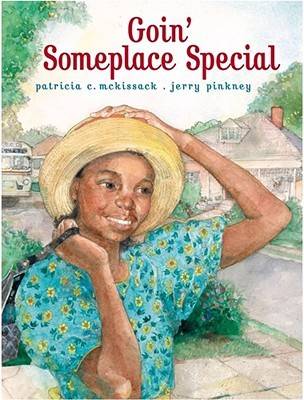

Goin' Someplace Special
by Jerry Pinkney and Patricia C. McKissack
The Barnes & Noble ReviewAuthor Patricia McKissack uses childhood memories of growing up in the segregated South to create this enlightening and touching story of one very special place. Young 'Tricia can't wait to make her very own journey to Someplace Special (her destination is revealed only at the end of the story). Her grandmother reluctantly lets her baby out on her own, but not without some words of advice. "Hold yo' head up and act like you b'long to somebody."As we soon find out, these powerful words will sustain Tricia during a rather disheartening journey through her native city as she encounters the harsh reality of segregation. As she enters the bus, she is forced to sit in the COLORED SECTION of seats in the back. When she spots a friend of her Grandmother, Tricia voices her anger. "It's not fair," she asserts. But as Mrs. Grannel points out, it's just the way it is. When Tricia gets off in downtown Nashville, she admires the Peace Fountain and looks to rest on a nearby bench. She quickly jumps up, as the bench graphically reads: FOR WHITES ONLY. As she makes her way through town she bumps into Mr. John Willis, the doorman at Southland Hotel. As he bestows compliments on the lovely girl, she is accidentally pushed into the lobby. Amidst all the hustle and bustle, Tricia can't get out. And the manager yells at her in front of every one, "No colored people allowed!". Just as Tricia is about to give up her voyage to Someplace Special, she runs into Blooming Mary, an older woman who tends to the Mission Church garden. Mary reminds here that Tricia can find strength in the words of her grandmother. Tricia takes heart from this encouragement and feels able to go on. But one more battle lies ahead. As Tricia passes a theater, a young white boy casually asks her if she's going to the show. Before she can reply, the boy's older sister angrily says, "Colored people can't come in the front door. They got to go 'round back and sit up in the Buzzard's Roost." Tricia keeps her head high, announcing that she'd never sit there -- she's headed someplace special. Readers finally learn where Tricia's journey has led her -- the library. The glorious building is large and imposing, its steps overflowing with people of all colors. And Tricia excitedly reads these special words: PUBLIC LIBRARY: ALL ARE WELCOME. McKissack's author note at the end of the book explains just how close this tale is to her heart and her life. When Nashville's public library board quietly decided to integrate the facilities, it became one of very few places that did not feature Jim Crow signs. This touching story provides personal insight into a time that might be hard to understand for young readers. The text is beautifully written, with the perfect amount of dialogue on each page. Adding to the brilliant words of McKissack are the outstanding pencil and watercolor illustrations from the talented Jerry Pinkney. Each spread comes alive with the sights of the 1950s. The details of Tricia's face, and the family friends she encounters on her journey, speak volumes about the joy and suffering of life in segregated America. Tricia's dress, like Tricia herself, is bursting with life and optimism, providing a visual thread throughout the story.This dynamic offering from the outstanding talents of McKissack and Pinkney is more than a springboard for conversation; it's also a stunning portrait of strength and beauty for every reader. (Amy Barkat)
Release Date:
August 31, 2001

